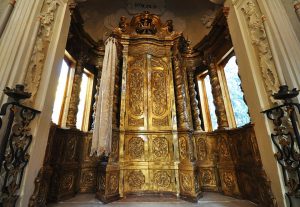FEATURES Mantua, a Long Jewish History
The first extent mention of Jews living in the ancient northern Italian city of Mantua (Mantova) dates to around 1145. Soon after this, Abraham ibn Ezra (1089-1167), one of the most important Jewish biblical commentators and philosophers of the Middle Ages, stayed for a time in the city, during his exilic journeys. There are no further references to Jews in connection with Mantua until they are mentioned in the new statutes of the city at the end of the fourteenth century, when a relatively large number seem to have lived there.
During the 1400’s the treatment of the Jews varied, and occasionally they were favored by the ruling Gonzaga family. Federico I Gonzaga (1441-84), Marquis of Mantua, had a Jewish physician, but he forbade Jews to keep Christian servants, an exception being made in regard to necessary services performed on the Sabbath. Under the Gonzagas, who generally encouraged the activities and talents of their Jewish subjects, Mantua was a haven of relative racial and cultural tolerance and the community showed significant growth. During the 1500s, Jews made up 7-8% of the population of the city. As the community grew, it went from being made up mostly of money lenders and their families to including merchants, teachers, and rabbis. (The city’s Jewish population reached its numerical peak in 1858 with 2,523 Jews.)
The fluctuating treatment of the Jews in Mantua continued throughout this period. In 1486 a Christian loan bank was created in Mantua in direct competition with Jewish banking. Anti-Jewish riots took place at Mantua throughout the 15th century, furthered by the Church and encouraged by the Jews’ business competitors. The harsher stances of the Church during the counter-reformation period proved harmful to the Jews of Mantua by the end of the 16th century when discriminatory measures and anti-Jewish propaganda culminated in riots and murder. The worst outrage occurred in 1602, when seven Jews were hanged on a charge of blasphemy at the initiation of a Franciscan monk. The period of relative tranquility that the Jews of Mantova enjoyed from the 15th through the 17th century come to a tragic end in 1629 when, during the War of Mantuan Succession, the synagogue was desecrated, the ghetto was sacked and the Jews were expelled from the city. This event devastated the Jewish Mantuan community, which never fully recover.
Aside from these hardships, the 16th and 17th century showed Mantua to be the heart of thriving Jewish life. They made important contributions to the development of Jewish communal institutions in Italy. The synagogues of Mantua included the great synagogue of the Italian rite, and several smaller synagogues of the Ashkenazi and Italian rites. The community maintained a public-school system and welfare institutions, including medical services for the poor.
Unique to Mantova was the leading role that Jews played in the arts of this city, which was renowned during the Renaissance as a center of dazzling visual, theatrical and musical art. Jewish performers became so popular that Christian neighbors insisted on attending their performances, in violation of Church prohibition. The Gonzagas took notice of the artistic inclination of their Jewish subjects and instituted a kind of tax on the Jewish community, obliging them to provide annual spectacular theatrical performances for the court and for visiting dignitaries. Mantova was the only city in Italy with this kind of arrangement. This fervid artistic atmosphere gave rise to the first modern stage director, the Jewish-Mantovan dramaturge, Leone de’ Sommi (1525-1590), and the celebrated Renaissance violinist and composer, Salomone de’ Rossi (1570-1630).
*Jenna Lustbader is a student at Muhlenberg College (Allentown, Pennsylvania, USA).

